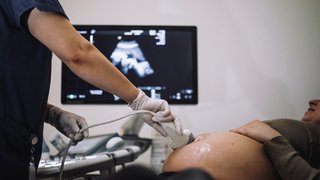Glucose guide: Monitoring blood sugar during pregnancy
September 17, 2024

Getting accurate blood sugar levels is crucial for pregnant patients with Type 1 or Type 2 diabetes or gestational diabetes – a result of increased insulin resistance that develops during as many as 9% of pregnancies in the U.S.
During pregnancy, glucose (blood sugar) is freely transported across the placenta. So, the blood sugar levels of a patient can affect the pregnancy, increasing the risk of complications such as:
- Premature birth
- Stillbirth
- Birth defects, especially if a test called hemoglobin A1c that measures average blood sugar levels over three months is above 7% at the time of conception
- Preeclampsia, which is high blood pressure during pregnancy
- Large baby size, which can result in birth injury or the need for a Cesarean delivery
- Need for neonatal intensive care unit (NICU) due to hypoglycemia (low blood sugar) in the newborn after delivery
For a better chance at a healthy pregnancy, you need the right blood sugar monitoring system. Monitoring your blood sugar tells you and your health care provider whether your daily food and exercise routine and medications such as insulin are working or need adjustments.
Moms-to-be today can choose between traditional blood glucose monitoring (BGM), which uses test strips and a finger prick at select intervals, and continuous glucose monitoring (CGM), which measures blood sugar 24/7 using an implant under the skin. But which one is best for you?
Our patients have shared their experiences with both types of monitoring, and at the end of the day, the best choice is the system that works for your lifestyle and budget. Here’s a review of each system, along with tips to get a good blood sugar reading with the method you choose.
Traditional blood glucose monitoring
How it works: For this method, you’ll need disposable test strips and a blood glucose monitor. A finger prick drops blood onto a test strip that reacts with glucose. The glucose generates an electrical signal. The reader translates this current into your blood sugar level.

Cost: The glucose monitor can be bought over the counter or with a prescription and can range from $20 to $35. Meanwhile, test strips can be purchased for up to $150 for 100 strips. If you’re testing your blood sugar levels at least four times a day, as recommended, a pack of strips will last 25 days or less. Meters and test strips are usually covered to some extent by insurance.
Ease of use: Test strips are a bit more difficult to use than continuous glucose monitoring. You’ll have to prick your finger multiple times a day for accurate results. Most people get used to the sensation, but it still isn’t fun. Wash your hands before and after testing and follow instructions for use and storage on the package.
TIPS: Warm your fingers, and milk the blood toward the fingertip. Test toward the sides of your finger pads, not directly in the middle. Rotate for each evaluation (thumb left of midline, then thumb right of midline, pointer left of midline, then pointer right of midline, etc.). Consider not using your pinky finger.
Accuracy: The U.S. Food and Drug Administration requires that all blood glucose monitors be accurate within 15%-20% of the laboratory reading. This means that you can trust your blood glucose reading at home. However, readings can become more inaccurate due to user error. Storing your strips in a hot car, for example, can damage their efficacy.
Using the results: Test strips provide a direct glucose measurement from a single blood sample, giving you a snapshot of your blood sugar at that moment. You’ll likely have to keep a log to get an idea of trends over time.
Continuous glucose monitoring
How it works: Continuous glucose monitoring tracks blood glucose levels using a tiny sensor under the skin. Most devices have an automatic application device that helps deploy the sensor. The sensor measures glucose levels in the fluid between cells and transmits the data to a receiver or smartphone. You can know your blood glucose levels at all times of the day. You'll have to replace the sensor every 1-2 weeks for the best accuracy.

Cost. Costs typically range from about $1,000 to several thousand dollars a year without insurance. With insurance that cost can be much lower, but insurance often only covers this for people taking insulin regularly at this time.
Ease of use: With continuous glucose monitoring, all you need to do is place the device on the back of your upper arm and put a patch over it for protection. It typically is not painful while in place, but care must be taken to avoid accidentally removing it.
Accuracy: The FreeStyle Libre device has shown a 92% accuracy rate compared with lab results, while other monitors have closer to an 89% accuracy rate. However, I do have patients who have told me that their continuous glucose monitors are prone to technical difficulties, such as incorrect readings when pressure is applied to the sensor “pressure lows,” which can be more impactful overnight. I always recommend having a blood glucose meter to validate the continuous glucose monitoring values a few times per week, and it’s good to have a backup on hand.
Using the results: Many continuous glucose monitors will give an alert if your blood sugar is too high or too low, even before you feel the symptoms. This can be helpful for many. Some continuous glucose monitors also come with apps that can communicate directly with your doctor, while others can give you additional statistics and analysis about your blood glucose levels.
My experience with continuous glucose monitoring
A few months ago, I decided to try using a continuous glucose monitor for myself for eight weeks, as they can be purchased without a prescription online – I wanted to better understand what my patients were experiencing. I found it easy to use and not painful, though I did get some skin irritation from the patch. The patch was clearly visible, which may be a deterrent for people who want discretion. I found that if I slept on the device, it reported a very low blood sugar. I also had one device that persistently reported low glucose values for several days regardless of what I ate or did, so clearly it was not providing accurate data.
Continuous glucose monitors can be a great option for busy people who don’t enjoy the sensation of a finger prick. However, the monitor is prone to technical errors. It’s important to have test strips on hand to confirm readings that don’t feel accurate.
Because so much of the cost of glucose monitoring is dependent on insurance, it’s difficult for me to make one-size-fits-all recommendations. In my maternal-fetal medicine office at UT Southwestern, we are happy to write prescriptions for both types of monitors, so you’ll be able to choose to pay cash at the pharmacy for a continuous glucose monitor if having that is valuable to you.
When to test
* Immediately after waking
* Two hours after breakfast
* Two hours after lunch
* Two hours after dinner
Tips for accurate readings
For most of my pregnant patients, especially those new to glucose monitoring, I recommend tracking and logging your blood sugar four times a day.
Why one to two hours? The delay gives time for glucose to be absorbed into your cells. If you tested right after eating, there wouldn’t be time for the body to break down the glucose, and you’d have an elevated number that could cause unnecessary worry. Additionally, the data that we have on pregnancy outcomes is based on that time frame. If someone is busy or has a meeting that would hinder two-hour checks, a check after one hour can also be done, and I ask them to make a notation so we know the goal glucose level for that time.
As for your morning reading, I recommend that you do it first thing before you get out of bed and begin your routine. Otherwise, your cortisol (stress) hormone might push your blood sugar levels higher. The ideal blood glucose targets vary by patient, but generally I recommend aiming for a fasting level of less than 95 milligrams per deciliter (mg/dL) or at least less than 105 mg/dL and less than 120 mg/dL two hours after meals or less than 130 mg/dL one hour after a meal. I also recommend testing any time someone feels weak or shaky or sweaty, which can be symptoms of low blood glucose.
For patients that I manage, I ask for a weekly report of their blood sugar levels through MyChart, uploaded every Sunday evening or by Monday morning. When I get the full picture, I can notice trends. If you’ve had a difficult day with high blood sugar, I can put it in the context of your other readings to see whether it’s an anomaly or part of a pattern that will require medical intervention.
Managing glucose during pregnancy
In addition to monitoring glucose, I typically recommend some lifestyle changes for pregnant patients dealing with gestational diabetes or another form of diabetes. These changes focus on food and exercise.
The most important part of a diet during diabetes is to focus on balance. Carbs remain valuable, but not in excess. Prioritize proteins (lean meats, tofu, beans) and healthy fats (avocado, olive oil) – these should make up most of your plate – with the rest being high-fiber carbohydrates and non-starchy vegetables. There may be some trigger foods that you’d want to avoid, such as sweets or processed foods. Protein and fiber have the extra benefit of making you feel more satiated for longer. Consider working with a culinary medicine expert or dietitian to create a plan that feels sustainable for you.
Physical exercise can lower glucose levels for up to 24 hours after exercise, though the exact effect will depend on the individual. During pregnancy you’ll want to avoid high-impact sports, but there are still excellent options. For my pregnant patients with diabetes, as long as there are no other health reasons that would raise concerns, I recommend walking, swimming, stationary bike, elliptical, and yoga. These activities can help you gain the health benefits of exercise without compromising the safety of you or your fetus.
Related reading: Be SMART about setting health-related goals
What happens after pregnancy?
Some patients diagnosed with gestational diabetes may have had pre-diabetes or even diabetes but were unaware of it before their pregnancy.
One of the key features of the postpartum visit is a glucose screening 4-12 weeks after delivery to see whether blood sugar levels are returning to normal. If diabetes persists, the patient can transition to a primary care provider to ensure they continue with good glucose control.
Did you know that gestational diabetes was originally used to assess who might get diabetes in the future? About half of those who have gestational diabetes will be diagnosed with diabetes in the future. How can you reduce your risk?
- Breastfeed, if possible
- Continue to refrain from high-sugar foods and processed carbohydrates
- Achieve your ideal body weight
- Optimize your strength. Muscles use more of the glucose in your blood than other cell types in your body. Plus, strength training has other valuable benefits over your lifespan.
High glucose levels during pregnancy can be anxiety-inducing for many patients. Remember, gestational diabetes isn’t your fault. It’s a condition that can occur due to factors beyond your control.
With proper monitoring and support, you can ensure a healthy outcome for both you and your baby. Whether you go with continuous glucose monitoring, test strips, or a combination of the two, our team at UT Southwestern is ready to help you navigate your pregnancy and delivery.
To talk with a provider about blood glucose monitoring, call 214-645-8300 or request an appointment online.












